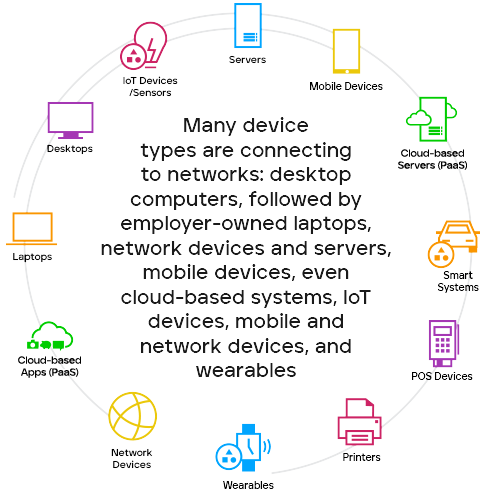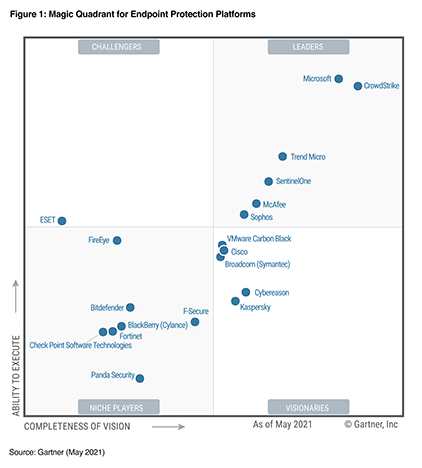What Is Endpoint Security?
Trellix Endpoint Security Earns SE Labs’ Highest AAA Rating for Enterprise & Small Business Customers |
Read Now
Endpoint security is the practice of securing endpoints or entry points of end-user devices such as desktops, laptops, and mobile devices from being exploited by malicious actors and campaigns.
Endpoint security systems protect these devices on a network or in the cloud from cybersecurity threats. Endpoint security has evolved from traditional antivirus software to providing comprehensive protection from sophisticated threats and ever-changing zero-day exploits.
Organizations of all sizes are at risk from nation-states, hacktivists, organized crime, and malicious and accidental insider threats. Endpoint security is often seen as cybersecurity's frontline. It represents one of the first places organizations look to secure their enterprise networks.
As the volume and sophistication of cybersecurity threats have steadily grown, so has the need for more advanced endpoint security solutions. Today’s endpoint protection systems are designed to quickly detect, analyze, block, and contain attacks before they can do damage.
To do so, they need to collaborate with each other and with other security technologies. This gives administrators visibility into advanced threats to speed detection and remediation response times.
Why is endpoint security important?
An endpoint protection platform (EPP) is a vital part of enterprise cybersecurity for several reasons. First, in today’s business world, data is the most valuable asset of a company—and to lose that data, or access to that data, could significantly hinder business operations and drive down revenue.
Businesses have also had to contend with not only a growing number of endpoints, but also a rise in the number of types of endpoints.
These factors on their own make enterprise endpoint security more difficult, but they’re compounded by remote work and bring your own device (BYOD) policies—which make perimeter security increasingly insufficient and create vulnerabilities.
The threat landscape is becoming more complicated, as well: Hackers are always coming up with new ways to gain access, steal information, or manipulate employees into giving out sensitive information.
Added to this list are the opportunity cost of reallocating resources from meeting business goals to addressing threats; the reputational cost of a large-scale breach; and the actual financial cost of compliance violations.
Given all these challenges, it’s easy to see why EPPs have come to be regarded as must-haves for securing modern enterprises.
How does endpoint protection work?
Endpoint security is the practice of safeguarding the data and workflows associated with the individual devices that connect to your network. EPPs work by examining files as they enter the network.
Modern EPPs harness the power of the cloud to hold an ever-growing database of threat information. This frees endpoints of the bloat associated with storing all this information locally and the maintenance required to keep these databases up to date. Accessing this data in the cloud also allows for greater speed and scalability.
The EPP provides system administrators with a centralized console, either locally or cloud-based, that allows them to control security for each device remotely. The client software is then assigned to each endpoint.
Once the endpoint has been set up, it can quickly detect malware and other threats. Updates can be pushed to the endpoints when necessary, log-in attempts can be authenticated from each device, and corporate policies can be administered from one location.
Some solutions also include an endpoint detection and response (EDR) component. EDR capabilities allow for the detection of more advanced threats, such as polymorphic attacks, fileless malware, and zero-day attacks. By employing continuous monitoring, the EDR solution can offer better visibility and a variety of response options.
EPP solutions are available in on-premises or cloud-based models. While cloud-based products are more scalable and can more easily integrate with your current architecture, certain regulatory/compliance rules may require on-premises security. Another reason organizations may choose on-premises security is that it provides the ability to own and control your data.
What is considered an endpoint?
If a device is connected to a network, it is considered an endpoint. With the growing popularity of BYOD and IoT (Internet of Things), the number of individual devices connected to an organization's network can quickly reach into the tens—and hundreds—of thousands.
Endpoints span a range of devices such as:
- Tablets
- Mobile devices
- Smart watches
- Printers
- Servers
- ATM machines
- Medical devices
Because they are entry points for threats and malware, endpoints—especially mobile and remote devices—are a favorite target of adversaries. Mobile endpoint devices have become much more than just Android devices and iPhones—think of the latest wearable watches, smart devices, voice-controlled digital assistants, and other IoT-enabled smart devices.
We now have network-connected sensors in our cars, airplanes, hospitals, and even on the drills of oil rigs. As the different types of endpoints have evolved and expanded, the security solutions that protect them have also had to adapt.

Endpoint security components
Typically, endpoint security software will include these key components:
- Machine-learning classification to detect zero-day threats in near real time
- Advanced antimalware and antivirus protection to protect, detect, and correct malware across multiple endpoint devices and operating systems
- Proactive web security to ensure safe browsing on the web
- Data classification and data loss prevention to prevent data loss and exfiltration
- Integrated firewall to block hostile network attacks
- Email gateway to block phishing and social engineering attempts targeting your employees
- Actionable threat forensics to allow administrators to quickly isolate infections
- Insider threat protection to safeguard against unintentional and malicious actions
- Centralized endpoint management platform to improve visibility and simplify operations
- Endpoint, email and disk encryption to prevent data exfiltration
- Application and change control to prevent unauthorized users from making changes to existing applications, or installing new ones
How enterprise endpoint protection differs from consumer endpoint protection
Enterprise Endpoint Security Protection
Consumer Endpoint Security Protection
Scales seamlessly to hundreds of thousands of endpoints
Required to manage just a small number of single-user endpoints
Better at managing diverse collections of endpoints
Required to manage just a small number of single-user endpoints
Central management hub software
Endpoints individually set up and configured
Remote administration capabilities
Rarely requires remote management
Configures endpoint protection on devices remotely
Configures endpoint protection directly to device
Deploys patches to all relevant endpoints
User enables automatic updates for each device
Requires modified permissions
Uses administrative permissions
Ability to monitor employee devices, activity, and behavior
Activity and behavior limited to sole user
How to choose an endpoint security solution— 3 questions
To protect your business, you need a comprehensive and unified solution that shields devices and endpoints across your hybrid network. Here are three critical questions to ask when choosing an endpoint security solution:
Question #1: How comprehensive is the endpoint protection?
The solution you choose should proactively guard against threats using robust capabilities for prevention, detection, investigation, and response. It should allow you to gain visibility across your on-premises, cloud, and disconnected environments in a single agent and control all your endpoints.
Question #2: Does the endpoint security solution offer centralized management?
You need to be able to easily scale and manage hundreds of thousands of endpoints from a single console to eliminate security gaps and automate your workflows.
Question #3: Does the endpoint security solution enable proactive risk management?
Staying ahead of threats is key to warding off adversaries. Your endpoint security solution should provide AI-powered proactive threat prioritization, automated alert correlation, and MITRE ATT&CK mapping for predictive security posture assessments.
How Trellix can help
Trellix endpoint security solutions enable you to address complex, distributed security issues quickly and thoroughly:
Trellix Endpoint Security: Provides multi-layered endpoint protection spanning your on-premises, cloud, and disconnected environments in a single agent, and managed from a single source, ensuring all security components work seamlessly to provide robust protection across all vectors.
Trellix Endpoint Detection and Response (EDR): Powered by Trellix Wise AI, our EDR solution reduces alert fatigue with automated alert investigation and correlation. It proactively contextualizes threats for efficient investigation and continuously monitors your environment for comprehensive threat detection and response.
Trellix Endpoint Forensics (HX): Allows you to perform fast, targeted forensic investigations across thousands of endpoints. Quickly collect forensics data including process, memory, and files to scope the blast radius of a breach and confidently return to a known good state.
By combining these products and approaches, Trellix provides a robust endpoint security solution that helps organizations prevent, detect, investigate, and respond to threats efficiently and effectively.
